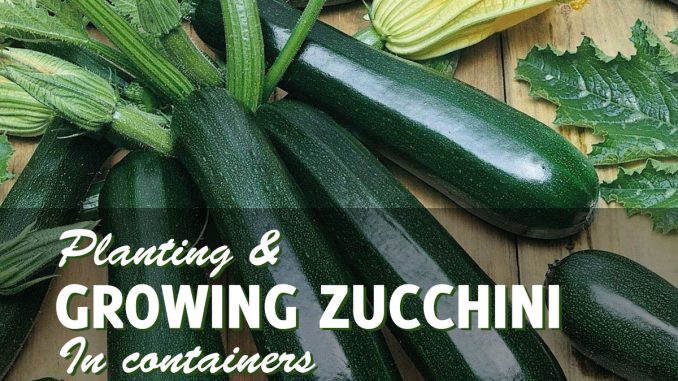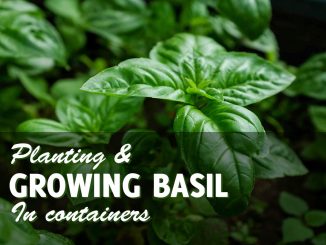
Zucchini is a versatile vegetable that is among the family of summer squash. It produces a yield faster than any summer squash variety, yielding a vegetable that is cylindrical with dark green firm skin and milky white juicy flesh.
A small garden is not a problem for it is effortless to start growing zucchini in containers. The flavor of your own home-grown zucchini is far superior to those bought in grocery stores. Choosing to grow them organically will give you a yield that has twice the flavor and texture compared to conventional gardening.
Before You Start Growing Zucchini in Containers
Choose a variety of zucchini that suits your flavor. Once you have chosen your variety of zucchini, select a place that has at least 8 hours of full sun in a day. It is a warm-weather crop and very susceptible to the effects of frost or extreme cold. Wait until the soil has warmed up, and the possibility of frost has passed before you start growing zucchini in containers. You may start your cultivation indoors if you cannot wait to get started with your crops. Make sure that you harden off seedlings before you transfer your pots outside of your home.
Choosing the Right Container for Zucchini
The specification of your container for zucchini is very important. There are a variety of containers to choose from. You can select between wood (semi-porous), terracotta or clay pots (porous) or plastic (non-porous) pots.
If you live in a cool climate, you can use the traditional terracotta pots for your zucchini. In warmer climates, wooden window boxes are ideal since they insulate the soil of your crops better. If wood is too expensive, you can use a plastic container or a pail. Pail containers need to be at least 1 gallon to hold a plant.
5-gallon buckets can hold one to two zucchini plants. A container that is at least 24 inches deep and 24 inches wide will be enough for one plant. A container that is five feet long, 3 feet wide, and 2 feet deep will probably hold 2-3 zucchini plants together. Do consider spacing when growing zucchini in pots as over-crowding leads to low resistance against disease and infestations.
Drill at least four holes underneath small containers. More is better, of course, especially with big containers, as long as it is enough to drain excess water as well as keep in moisture. Line the bottom with small pieces of terra cotta pots, small pebbles, or small stones to prevent soil erosion. You can also use fiberglass mesh net to line the bottom for this purpose and also to prevent pests from getting into your containers.
Preparing Your Potting Mix for Growing Zucchini in Containers
Do not use ordinary garden soil for container gardening. Ordinary garden soil is often infested with fungus, viruses, and bacteria that can harm your crops. Remember that container gardening holds in more heat, and that can cause dormant pathogens to multiply and infect your plant.
It is best to invest in a good potting mix in your local garden store for growing zucchini in containers. Potting mixes are made with pasteurized soil, perlite, vermiculite, and compost. This mix ensures better absorption of water and nutrients but light enough to promote drainage of excess water. A pH of 6.0-7.5 is preferred for the healthy growth of zucchini.
Test your soil and adjust the pH with lime to increase the pH and sulfur to decrease. Two weeks before planting, add in fertilizer according to package instructions. Better yet, organic gardening would be best for cultivating zucchini as you will be using fewer chemicals that can end up in the zucchini (and you) and the environment. Incorporate a good amount of organic matter such as compost, composted manure, or organic liquid fertilizer for adequate soil nourishment.
Seeds & Planting
You can buy seeds from your local garden store or a local farmer’s market and since each packet contains 50 seeds you will only need one. Five seeds are enough for you to start cultivating zucchini for your family – and your neighbors as well. Depending upon the time of year and your location you may have issues finding seeds locally; in this event you can find great zucchini seeds online as well.
If you wish to start growing your seeds indoors, plant your seeds in March and April. Outdoor container gardening should start around May and June. Ideally, seeds are started indoors about 3-4 weeks before the last average frost date in your area.
If you are using a small container, place three seeds on top of the soil at the center 3 inches apart in a circular pattern. Cover with compost ¾ inch thick but do not pack the soil. Water with a fine hose until the water runs through the drainage holes. Maintaining a temperature of 68-77F will ensure germination in 5-10 days. Thin your plants buy cutting the weak ones, leaving just one seedling behind. Cut the other seedlings close to the soil’s surface once two true leaves have formed. If you are using a large container, plant the seeds 4 inches apart in the same manner. Thin to 24″ distance between each seedling. Do not be stingy with your thinning as overcrowding weakens your crops.
Seedlings started indoors must be hardened off before being transferred outside when growing zucchini in pots. You can start with a small 8″ container that is made of biodegradable material. Leave the seedlings in the containers and just cut out the bottom part before putting the seedling deep inside a larger container. Dig a hole that is as big but slightly deeper than your small container. Place 2 inches of compost at the bottom and place your seedling inside. Cover up to the level of the container and top it with an inch of compost and water your crops until it flows through the drainage holes.
Care of Your Container Zucchini
Watering and Fertilizing
Keep your plants healthy by keeping the soil moist but not wet. Give them slow-release fertilizer according to package instructions or side-dress your plants with aged compost manure every month. Feed your crops with compost tea twice a week and spray your plants with it every two to three days to ward off pests and other diseases.
Pests and Diseases
Powdery mildew is a problem with growing zucchini in containers. Keep it at bay by letting the air circulate between crops and keeping the leaves dry during watering sessions. If your plant is infected, cut off any affected leaf dispose of it properly to prevent cross-contamination. According to PennState University, you can spray your plant with equisetum concentrate or compost tea afterward to increase your plant’s resistance. Personally, I have had great results with organic neem oil.
To keep pests away, place calendula and nasturtiums in pots near your zucchini. These edible flowers will deter common bug problems that hurt zucchini. Slugs and snails can be controlled by hand-picking them or setting up a slug trap of lettuce leaves near your crops. You can also line the containers with copper tape to keep them at bay. Check under the leaves to look for hiding pests – as well as zucchini.
Harvesting Your Container Grown Zucchini
You must harvest them once they reach around 8” and 1 ½“ in diameter. Any longer and you will be eating zucchini that is dry and tasteless. It really isn’t hard to get a huge harvest when growing zucchini in containers. Keep to these simple guidelines, and you will be growing your own zucchini for a bountiful harvest.
Looking to grow other vegetables as well? Have a look at our guide on growing cabbage in containers.




Be the first to comment